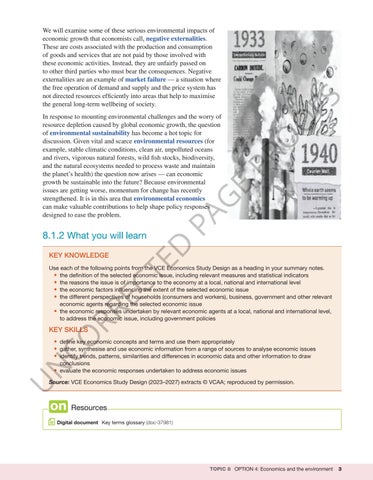“c08EconomicsAndTheEnvironment_PrintPDF” — 2022/6/6 — 17:03 — page 3 — #3
O O PR
PA
G
E
In response to mounting environmental challenges and the worry of resource depletion caused by global economic growth, the question of environmental sustainability has become a hot topic for discussion. Given vital and scarce environmental resources (for example, stable climatic conditions, clean air, unpolluted oceans and rivers, vigorous natural forests, wild fish stocks, biodiversity, and the natural ecosystems needed to process waste and maintain the planet’s health) the question now arises — can economic growth be sustainable into the future? Because environmental issues are getting worse, momentum for change has recently strengthened. It is in this area that environmental economics can make valuable contributions to help shape policy responses designed to ease the problem.
FS
We will examine some of these serious environmental impacts of economic growth that economists call, negative externalities. These are costs associated with the production and consumption of goods and services that are not paid by those involved with these economic activities. Instead, they are unfairly passed on to other third parties who must bear the consequences. Negative externalities are an example of market failure — a situation where the free operation of demand and supply and the price system has not directed resources efficiently into areas that help to maximise the general long-term wellbeing of society.
TE
KEY KNOWLEDGE
D
8.1.2 What you will learn
CO RR EC
Use each of the following points from the VCE Economics Study Design as a heading in your summary notes. • the definition of the selected economic issue, including relevant measures and statistical indicators • the reasons the issue is of importance to the economy at a local, national and international level • the economic factors influencing the extent of the selected economic issue • the different perspectives of households (consumers and workers), business, government and other relevant economic agents regarding the selected economic issue • the economic responses undertaken by relevant economic agents at a local, national and international level, to address the economic issue, including government policies
KEY SKILLS
N
• define key economic concepts and terms and use them appropriately • gather, synthesise and use economic information from a range of sources to analyse economic issues • identify trends, patterns, similarities and differences in economic data and other information to draw conclusions • evaluate the economic responses undertaken to address economic issues
U
Source: VCE Economics Study Design (2023–2027) extracts © VCAA; reproduced by permission.
Resources
Resourceseses
Digital document Key terms glossary (doc-37981)
TOPIC 8 OPTION 4: Economics and the environment
3





















































